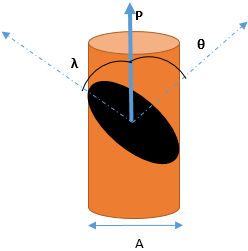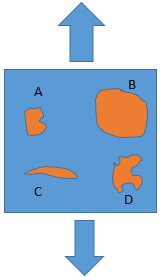This set of Mechanical Metallurgy Multiple Choice Questions & Answers (MCQs) focuses on “Griffith Theory of Brittle Fracture – 1”.
1. The brittle fracture of single crystal is related with __________________ on the cleavage plane.
a) critical resolved shear stress
b) critical resolved normal stress
c) uniaxial tensile stress
d) uniaxial shear stress
View Answer
Explanation: The brittle fracture in single crystal occurs along the cleavage plane, and the Sohncke’s law states that fracture occurs when the resolved normal stress reaches a critical value.
2. For the given component, the critical resolved normal stress will be equal to _________ given that the load applied is equal to P and the normal and shear angle with loading directions are θ and λ.

a) P/A
b) P*cosθ
c) (P/A)*cosλ*cosθ
d) (P/A)*cosθ2
View Answer
Explanation: The Critical resolved normal stress will be the component of stress along the normal of the plane.
So, the area of normal plane A/cosθ
The component of stress along the normal direction is:
(P)*cosθ
So the stress will be = Load/Area
-> (P)*cosθ/(A/cosθ)
-> (P/A)*cosθ2.
3. For the given component the critical resolved shear stress will be equal to _________
Given that the load applied is equal to P and the normal and shear angle with loading directions are θ and λ.

a) P/A
b) P*cosθ
c) (P/A)*cosλ*cosθ
d) (P/A)*cosθ2
View Answer
Explanation: The critical resolved shear stress will be the component of stress along the normal of the plane.
So, the area of normal plane A/cosθ
The component of stress along the normal direction is:
(P)*cosλ
So the stress will be = Load/Area
-> (P)*cosλ/(A/cosθ)
-> (P/A)*cosλ*cosθ.
4. The FCC material’s usual mode of fracture is necked down to a point before rupture.
a) True
b) False
View Answer
Explanation: The FCC is generally necked down to a point because there exists multiple slip system and slip co-occurs. This is followed by the slip on a single system.
5. For ductile material, best way to predict the failure in stress is by examining __________
a) critical resolved shear stress
b) critical resolved normal stress
c) uniaxial tensile stress
d) uniaxial shear stress
View Answer
Explanation: The FCC is generally ductile and drawn down to a point, so the critical resolved shear is the best way to predict the failure stress.
6. The mode of fracture is more temperature-dependent in FCC material than in BCC material.
a) True
b) False
View Answer
Explanation: The BCC material is more temperature-dependent than FCC material. Along with that, the BCC is more sensitive to purity, heat treatment, crystal orientation.
7. What is the temperature over which ductile material converts into a brittle material?
a) 100°
b) 10°
c) 50°
d) 2°
View Answer
Explanation: The ductile to brittle transition is a very sharp transition. With only a change in 2°, the material might become brittle from ductile. That is why it is considered very severe to find the DBTT for low-temperature alloys.
8. The formation of microcracks in metal can occur due to _________
a) inclusion
b) solute atom
c) dislocation
d) vacancy
View Answer
Explanation: Inclusion is the second phase where hard/Brittle particles are present in the metal matrix. Their presence creates a local region with high-stress concentration, which leads to micro cracking.
9. Which of the following inclusion is most severe for the metal?

a) A
b) B
c) C
d) D
View Answer
Explanation: The inclusion C shape is elongated in direction, and the sharp notch creates a region of high-stress concentration. Also, its direction is perpendicular to loading direction, so it will create maximum stress on the tip.
10. Which of the following steel will have the highest strength? (Given that the initial composition of raw material is the same for all).
a) Vacuum furnace melted steel
b) Induction furnace melted steel
c) Muffle furnace melted steel
d) Tube furnace melted steel
View Answer
Explanation: The vacuum furnace melted steel will have the highest strength because it will not pick up atmospheric gases and impurity at high temperatures. So they will have the least inclusion compared to other samples.
11. The most suitable instrument for fractography is _________
a) SEM
b) TEM
c) XRD
d) AFM
View Answer
Explanation: SEM has the highest depth of focus and depth of field. So the fracture surface can be seen much more clearly without losing the focus of the surface with different depths.
Sanfoundry Global Education & Learning Series – Mechanical Metallurgy.
To practice all areas of Mechanical Metallurgy, here is complete set of 1000+ Multiple Choice Questions and Answers.
If you find a mistake in question / option / answer, kindly take a screenshot and email to [email protected]
- Check Mechanical Metallurgy Books
- Apply for Metallurgical Engineering Internship
- Practice Metallurgical Engineering MCQs
- Check Metallurgical Engineering Books
